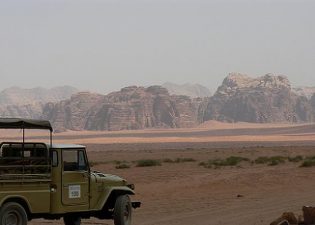 Researchers turn to high tech cameras to track sensitive animal populations in Jordan’s Dana Biosphere Nature Reserve.
Researchers turn to high tech cameras to track sensitive animal populations in Jordan’s Dana Biosphere Nature Reserve.
Using cameras equipped with ultra-violet sensors, Jordan’s Royal Society for the Conservation of Nature (RSCN) measures animal population and distribution, including female to juvenile ratios, male versus female numbers, and specific patterns of migration through the Reserve. RSCN is dedicated to protection and enhancement of Jordan’s natural environment; part of that mandate is to record key data about the Kingdom’s native plant and animal species.
They deployed 12 devices throughout the park, capable of daytime and nighttime recording. The cameras, activated by vibrations of approaching mammals, begin to record images when the creatures come within 10 meters.
Key “animal paparazzi” points included water sources, valleys and known migration routes.
The cameras, which record in dual media (video and still photography), have verified excellent results from recent conservation practices. The images document a 2011 population of 450 ibex, up from an initial count of 15 almost twenty years ago when this reserve was established.
Tracking biodiversity in the Dana Biosphere
Dana Biosphere is home to about 40 mammal species including striped hyenas, rock rabbits, wolves, Asiatic jackals and rare species of fox.The technology documented increasing populations of Caracal, Rock Hyrax, the endangered Ibex, and the rarified Bland Ford Fox, which was believed to be extinct.
According to ecologist Malik Al-Awaiji, the reserve is home to over 200 bird species and 800 plant varieties, three of which are plant species never known to exist. These discoveries are named Rohia danaiansis, Macromeria danaiansis and Salin danaiansis. “Work is ongoing to determine their properties,” he told the Ghana News Agency.
Dana Biosphere conducts critical biological research and conservation while allowing a high level of public access. Perched on the edge of Wadi Dana, and open year-round, the guesthouse offers breathtaking views of the reserve. It contains nine bedrooms, most with private terraces, as well as facilities for courses and conferences.
Bird Watching in Jordan
The park covers 310 square kilometers and boasts spectacular natural highs and lows: mountains 1,600 meters above sea level and valley gorges 150 meters below. It extends from the top of the Jordan Rift Valley to the desert lowlands of Wadi Araba and famed for its bird watching and archeological sites.
The reserve is one of Jordan’s major eco-tourism destinations, recording 40,000 visits last year with associated revenue of $425,000. Unfortunately, reserve carrying costs run about $565,000 per year.
Reserve estate manager, Mahmoud Bdour, said that the United States Agency for International Development (USAID) is providing $2.5 million to renovate dilapidated guest infrastructure including its sewerage system. It also receives support from the World Bank and the United Nations Development Program.
“I am optimistic, the project will enhance visitation and generate the needed revenue to further development, when completed”, said Bdour.
Jordan is host to other reserves, namely, Shamary, Azraq Wetland, Rum, Mujib Biosphere, Ajloun, Dippen and the newest, the Al Yarmoole reserve.



